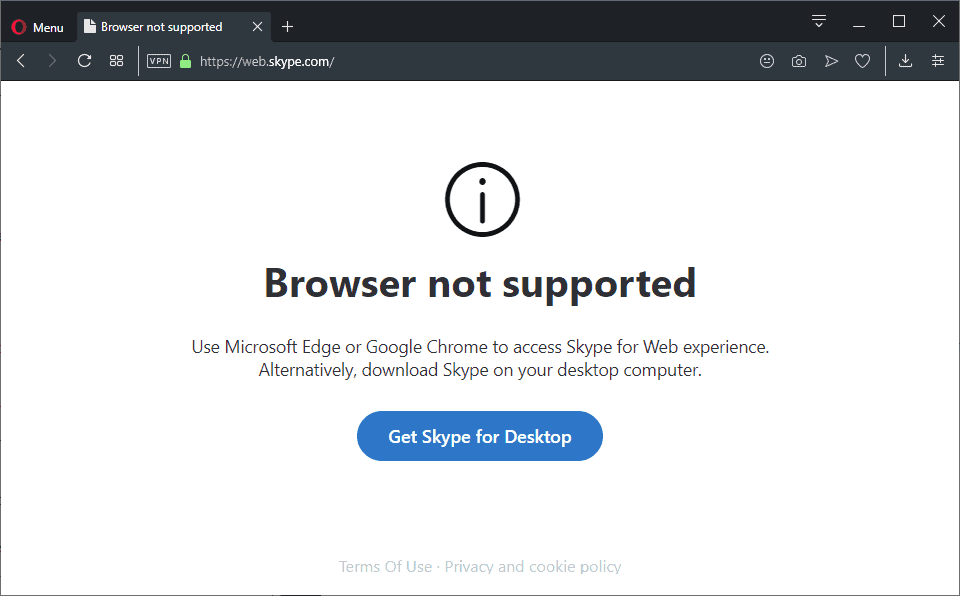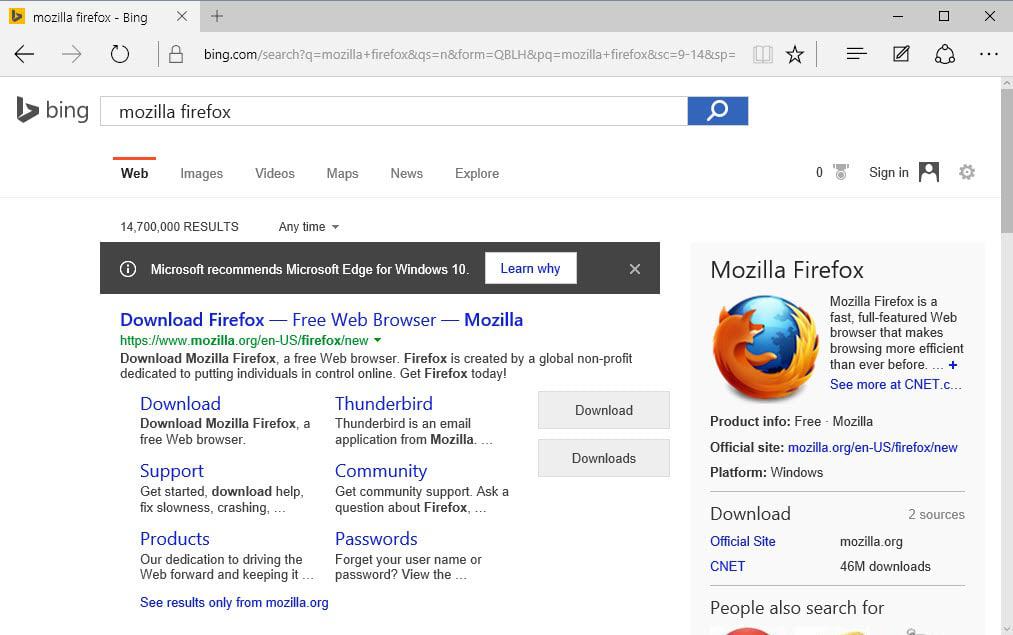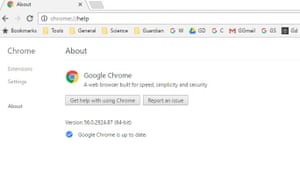Microsoft is trying to persuade users to keep Edge, the company’s new browser that replaces Internet Explorer, when they search for ‘Chrome’ or ‘Firefox’ on Bing. When you use Bing. So far I really loved it, however for some reason Microsoft Edge refuses to download anything, it just stays there at 0.00bytes forever! I have fully updated my Windows and there are no new updates available. Would really appreciate some advice. This also means Edge won’t work on older versions of Windows, so Windows 7 users can’t even think about using it–they’ll need to switch to Chrome to get a modern browser. Unlike Edge, Chrome is a mature piece of software complete with the years of interface refinement that Edge lacks. If you want to use a different version of Chrome, uninstall Google Chrome and then download and install it again. Can't install because you're not an administrator on Windows To check if you're an administrator.
For many people who purchase a new Windows 10 PC, Microsoft's built-in Edge browser has one purpose: to download an alternate browser like Google Chrome. The most common way to do this for people who don't have the URL memorized? Type 'download Chrome' in the address bar and click the first result provided by Bing search. Unfortunately those unsuspecting users have a high chance of downloading malware and adware. That's because Bing has been serving up malicious but highly visible Google Chrome ads for monthsDeceptive site ahead. Google and Firefox know this. Bing can't be bothered, apparently
Jason EvangelhoThis weekend, Twitter user Gabriel Landau enjoyed his first few hours with a Windows 10 laptop by doing this exact thing (video in Twitter link). The top result for his 'download chrome' search via Edge looked ordinary enough. Except that when he clicked it the resulting domain was 'GoogleOnline2018.com.' The fake site isn't an exact copy of Google's own Chrome landing page, but looks genuine enough to fool people. The download itself is called 'ChromeSetup.exe,' but examining the digital signature reveals 'Alpha Criteria Ltd.' That's definitely not Google.
Brand new Win10 laptop. Attempt to install Chrome. Almost get owned with my very first action. Why is this still happening in 2018, @bing? Please explain. pic.twitter.com/uYJhu7xa9H
— Gabriel Landau (@GabrielLandau) October 25, 2018
Download Google Chrome
Deceptive Site Ahead

Fortunately Landau was observant enough to detect something fishy was happening, but the way these deceptive ads are hijacking Bing is clever enough to fool the average user.
The malicious URL that Bing is happy to promote can't fool Google or Firefox. When I simply type the above URL into my Firefox browser I'm faced with a bold red page declaring 'Deceptive Site Ahead' completely with details and an option to go back.
Chris Hoffman, EIC of How-To Geek was able to reproduce this error, and several users on Twitter have also complained about it. In his article he points out that the ad comes into rotation every few page refreshes. Because I can't obtain that result on a fresh Windows 10 install, I suspect it may be targeting users geographically (I live in Europe).
I notified Bing Ads of this issue, and since Landau's tweet went viral overnight, I have confidence the malicious ad will be removed from Bing Search within the next 24 hours.
But the real issue is that it keeps happening.
I searched the web for similar complaints and found an article from Bleeping Computer dated April 2018. The same type of hijack using Bing Ads from Edge, displayed as the top result, leading to a fake Chrome download that serves up some particularly nasty adware in its installer. The most noticeable difference was the domain name 'NewChromeDownload.com.'
And then again 21 days ago from this user on Reddit. You guessed it. Same procedure, same structure, different domain name.
And then again about 4 months ago.
If you have to use Windows 10, don't use Bing for search. Ever.
MicrosoftThere's a pattern here, and it's a disturbing one. How many people have been affected by these short-lived but recurring hijacks that Microsoft is letting through to millions of people? It's inexcusable that these types of ads aren't vetted properly, especially when the majority of browsers automatically know these sites are unsafe.
Download Firefox
Isolated issues like this -- one search term in one browser with one search engine -- may not seem significant. But when looking at Windows 10 as a whole, things look considerably darker. Microsoft is letting devastating file-deleting bugs through its Windows 10 updates even after being warned by its team of Windows Insider testers. The update process is unreliable and cumbersome compared to operating systems like Ubuntu.
Download Chrome Browser For Windows
What You Can Do
If you must use Windows 10, go directly to Chrome.com to download Google's browser, or to Mozilla.org for Firefox. Commit those to memory or just open up Edge and browse directly to google.com. I also highly recommend installing a tracking blocker like DuckDuckGo. If you choose to use the Edge browser, remove Bing as your default search provider by following these steps.
At the very least, please do not use Bing to search for anything. Ever. You probably won't after reading this.
I'll update this article with any response from the Bing Ads team.
UPDATE: The Bing Ads Twitter account has removed the malicious ad and banned the account, saying 'Hi Gabriel, protecting customers from malicious content is a top priority and we have removed the ads from Bing and banned the associated account. We encourage users to continue to report this type of content at
https://bit.ly/2PZWZ1u
so we can take appropriate action.'
Is it a top priority? One can only hope Microsoft will be more vigilant going forward since this is a recurring problem with Bing.
If you have noticed a Download Failed – Virus detected message on Windows 10 when you tried to download a file from the internet using any browser like Chrome, Firefox, etc., then you need to know that it is your Windows Defender antivirus trying to protect your system from a potentially malicious download.
In the duplicitous world of internet, anti-virus software plays a pivotal role in curbing the system from software viruses. While we are recognizant of the potential threats from malicious programs, the anti-virus safeguards your system from security threats. The anti-virus tool impedes the user from downloading the untrusted software. With high rise in cybercrime, It’s always a good practice to have an antivirus software installed and keep it up to date.
While the antivirus program does the tremendous task by alerting you to the malicious file contained in the software you wish to download, you may sometime receive a false positive. By false positive we mean, the tool may wrongly indicate about the presence of malware in a software program. Although you believe in the authenticity of the site from where you wish to download, the browser prevents you from downloading the file by sending you an alert message about malware and antiviruses. In this scenario, it’s actually the antivirus software that is preventing you from downloading the file and its nothing to do with the browser.

Download Failed – Virus detected
If you are a Chrome user, the user is warned with the message “ Failed – Virus detected “. If the browser is Microsoft Edge, then you may be warned with the message “[filename] contained a virus and was deleted” and if you are on Windows Taskbar it simply displays the message “Malware detected”.
If you are quite sure about the authenticity of the source from where you are downloading the file, then you may want to set an exception in your antivirus software. In Windows 10, Microsoft Windows Defender is the built-in protection from malware that removes viruses and other unwanted files. The security programs sometimes block the file download on the Windows machines to protect from the security breach. You can resume the file download with some tweaks in Windows Defender.
The following steps will guide you in setting an exception in the Windows Defender software.
You should do this only if you are very sure that the file being downloaded is safe and from a trusted source.

Open Windows Defender Security Center and click on the Virus & threat protection shield. Scroll down a bit and click on Scan history. The following window will open.
If you see a file in the Quarantined threats section, identify and add the file that you just downloaded to the list of exclusions, by selecting Allow item.Once you do this, you will see the file under Allowed threats.
Now attempt to download the file again.
If you are still having a problem with downloading the file, then you may be using some other antivirus software that may be blocking the download. You may then have to whitelist the file in that software too.
Related Posts: